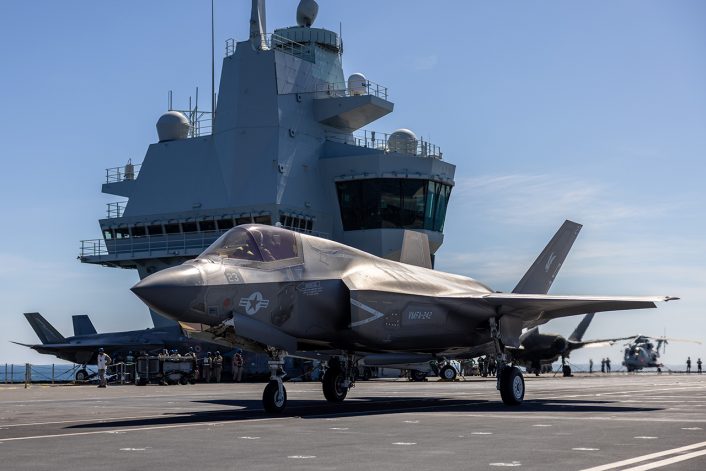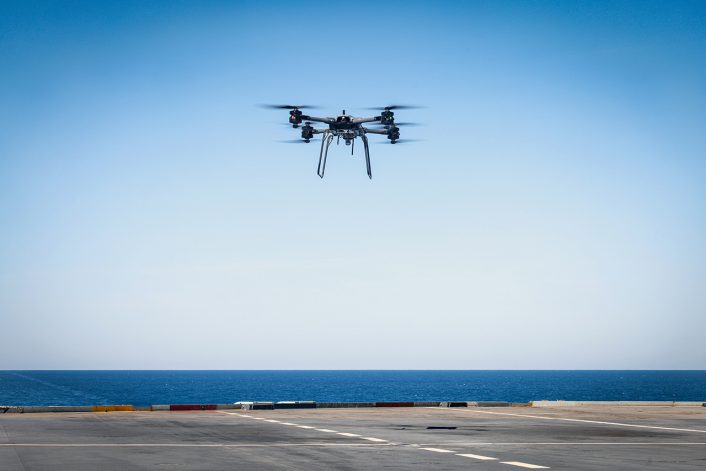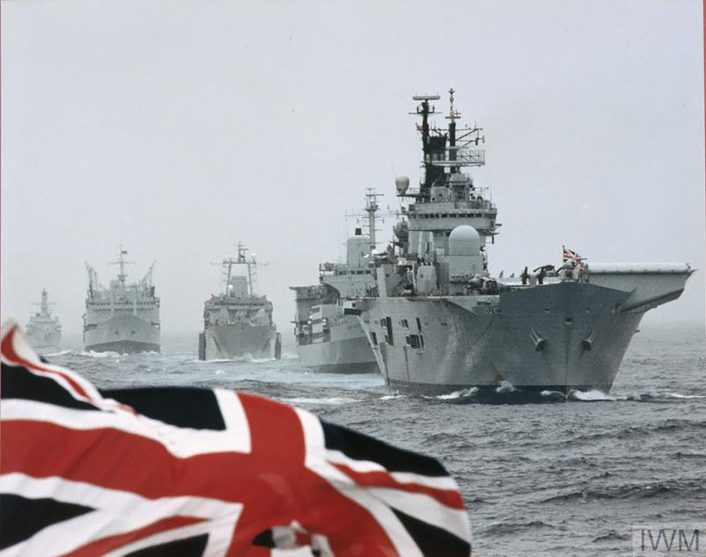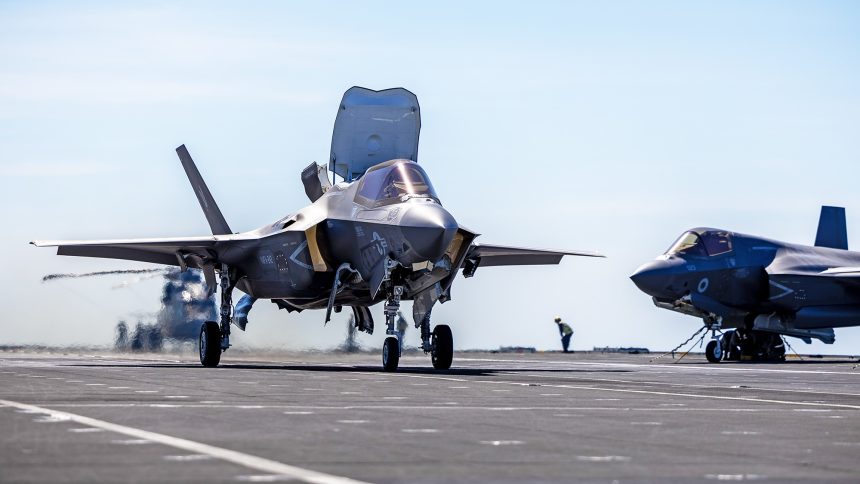U.S. Marine Corps F-35B Lightning II aircraft from the USS America have cross-decked onto the Royal Navy’s HMS Prince of Wales ahead of Exercise Talisman Sabre.
Currently sailing in waters near Australia while preparing for the beginning of Exercise Talisman Sabre, due to kick off on Jul. 13, 2025, HMS Prince of Wales (R09) hosted F-35B Lightning IIs from Marine Fighter Attack Squadron 242 (VMFA-242) ‘Bats’.
VMFA-242, based at Marine Corps Air Station Iwakuni in Japan, is deployed on board the amphibious assault ship USS America (LHA 6), which leads the America Amphibious Ready Group (ARG). At least two of the squadron’s F-35Bs – coded ‘23’ and ‘32’ – visited the British aircraft carrier on Jul. 8, where they are said to have completed hot pit refuels. Hot pit refueling is where an aircraft’s engine is kept running during refueling, which reduces the time taken to turn the aircraft around and get it back in the air.

HMS Prince of Wales is leading the Carrier Strike Group 25 deployment, which has taken the ship and its escorts from the UK, through the Mediterranean and Red Seas, the Indian Ocean, and through to the Australian coast via Singapore. Later in the voyage, the CSG will head north towards Japan. At some stage in August or September, HMS Prince of Wales will berth at the U.S. naval base in Yokosuka, while escorts HMS Dauntless (D33) and HNoMS Roald Amundsen (F311) will head to Japanese Maritime Self-Defense Force’s part of Yokosuka.
Already during its deployment, the Prince of Wales has hosted Italian F-35Bs during a similar exercise in the Mediterranean Sea. While the Queen Elizabeth class is often criticized for its lack of catapults and arresting wires – instead catering primarily for short takeoff and/or vertical landing (STOVL) or short takeoff and landing (STOL) aircraft – but it should be noted that there are in fact now more allied nations operating STOVL aircraft like the F-35B than there are those who operate CATOBAR aircraft. With STOVL operations being normal practice for the F-35B even when operating from land, it additionally requires little specific training for deck landings compared to catapults and wires.
U.S. Marine Corps F-35Bs were permanently embarked aboard HMS Queen Elizabeth (R08) during the Carrier Strike Group 21 deployment, augmenting the UK’s own F-35Bs. Now, with more jets delivered and more personnel trained, CSG 25 deployed with only UK F-35Bs in its air wing. 18 F-35Bs form the core part of the air wing, with more jets expected to attach temporarily later in the deployment to bring the on-board fleet to 24 – satisfying a full operating capability (FOC) requirement. There are currently 17 UK F-35Bs on board the ship after a technical issue forced one aircraft to divert to India in June, where it still remains.
Correction to previous post about F-35 in India.
Contrary to Indian media reports, no further work has been started and it is unlikely there will be a need to transport the jet home in a cargo aircraft.
A team of specialist engineers from the UK is due to arrive soon. (An… pic.twitter.com/tOU0MJzXWJ
— Navy Lookout (@NavyLookout) July 3, 2025
However, there is the possibility that in the near future the Queen Elizabeth class aircraft carriers will receive upgrades that could see some arrangement of catapults and arresting equipment retrofitted to the decks. These would likely be smaller systems compared to those of U.S. and French aircraft carriers, with the intention of widening the carriers’ ability to field emerging unmanned aircraft technology.
These ‘hybrid air wings’ featuring both manned and unmanned aircraft were endorsed by the recent UK Strategic Defence Review, released in June 2025. The review also suggested the possibility that the carriers could be used to directly launch cruise missiles, though it did not offer detail as to how this would be implemented.

At present, HMS Prince of Wales carries a small detachment of fixed wing and rotary wing unmanned aircraft from the Royal Navy’s 700X Squadron. RQ-20 Puma drones are utilised for intelligence, surveillance, and reconnaissance tasks, while Malloy T-150 electric vertical take-off and landing (eVTOL) UAVs are being trialed in a logistics capacity. The T-150 can be used to transfer smaller stores between ships in the task group, a role which would otherwise require the use of a Merlin or Wildcat helicopters’ precious flight hours.
Conflicting Interests
Notably, just a month before this cross-decking exercise, the U.S. Under Secretary of Defense for Policy Elbridge Colby is reported to have asked British defence officials whether their task group could be called back home. He is alleged by two anonymous sources speaking to Politico to have claimed “we don’t want you there”.
This is incredible. Not literally incredible — it’s entirely predictable. So, shocking, I suppose. https://t.co/fRmJImOrw6 pic.twitter.com/7hcmrmOtI2
— Noah Rothman (@NoahCRothman) July 9, 2025
The British representatives were said to be shocked by the statements, particularly so given the encouragement given by previous U.S. administrations towards the UK’s Pacific ‘tilt’. Historically speaking, the UK has long staked a significant presence in the Indo-Pacific region – while the British Empire is no more, the Commonwealth remains and many strong, long-lasting partnerships have been formed both with these nations as well as those outside of Britain’s historic influence.
Japan, particularly, has significantly strengthened its co-operation with the UK on defence matters. The two nations are partners in the Global Combat Air Programme (GCAP), with the aim of producing a sixth generation fighter aircraft by the mid 2030s. British Army units have also visited the Pacific nation on a number of occasions in recent years to join Japanese forces in exercises. A highly anticipated port visit to Yokosuka by HMS Queen Elizabeth in 2021 was unfortunately dampened by the COVID-19 pandemic, with crew members not able to leave the ship.
Royal Navy deployments to the Far East have, in fact, been a regular occurrence for decades. It is only in recent years that the pace has slipped somewhat due to declining fleet numbers and increased pressures from operations elsewhere.
Even as the permanent UK presence in the region, based from Hong Kong, was about to cease with the hand-over of sovereignty to China, the Royal Navy commenced Ocean Wave 97. Ocean Wave 97 took aircraft carrier HMS Illustrious (R06) and a sizable escort fleet on visits to a large list of East Asian and Pacific nations. Frigates detached from the main group even berthed in Ho Chi Minh City, Vietnam, and Vladivostok, Russia. Remarkably, there are in fact personnel currently deployed with Carrier Strike Group 25 who were also part of Ocean Wave 97.

In the years following, the flagship aircraft carriers and amphibious ships of the fleet were largely tied up by conflicts in Eastern Europe and the Middle East. However, individual frigates and destroyers still routinely made trips to the Far East each year. In 2009, a group headed by amphibious assault ships HMS Ocean (L12) and HMS Bulwark (L15) led the Taurus 09 deployment, the largest single deployment then undertaken by the Royal Navy in a decade. The deployment culminated in Singapore, featuring a number of amphibious exercises, anti-submarine warfare exercises, and anti-piracy operations during its course.
Orient Express ’83 involved the deploymet of the carrier group to the Pacific, including a visit to Australia, marred by controversy over whether she was carryng nuclear weapons, and exercises with the USS Kitty Hawk group in the South China Sea./5 pic.twitter.com/sLjy7DCyiV
— Engaging Strategy (@EngageStrategy1) May 2, 2021
Before HMS Queen Elizabeth’s Carrier Strike Group 21 deployment in 2021, the last Royal Navy aircraft carrier to visit the region was HMS Illustrious in 2013. Joined by HMS Daring, a Type 45 destroyer, the aircraft carrier deployed with a helicopter air wing (the Harrier force having been retired in 2011) to assist with aid operations in the Philippines following Typhoon Haiyan. Illustrious was decommissioned the following year, with HMS Ocean taking over helicopter carrier duties following a refit. Ocean would remain in service until 2018, by which time HMS Queen Elizabeth (R08) was undergoing sea trials.









